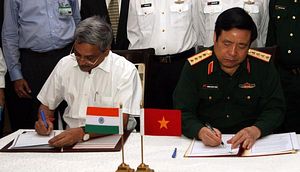Vietnamese Defense Minister Phùng Quang Thanh is in India for a three-day visit this week. On Monday, Thanh met with Indian Prime Minister Narendra Modi and Defense Minister Manohar Parrikar. Thanh’s visit to India is intended to bolster strategic ties between India and Vietnam and comes at a time of rising tensions in the South China Sea–where Vietnam disputes the sovereignty of various islands and reefs with China. Additionally, the Indian government has framed its approach toward Vietnam in terms of its proactive “Act East” policy. Parallel to Thanh’s visit to New Delhi, Indian and Vietnamese senior diplomats held their seventh deputy ministerial-level political consultation in Hanoi.
According to a statement posted on the Indian Prime Minister’s Office (PMO) website, “Gen. Thanh briefed Prime Minister Modi about defence and security related developments in the India-Vietnam bilateral relationship. Prime Minister Modi expressed satisfaction at the progress made in bilateral defence and security cooperation since the visit of Prime Minister Nguyen Tan Dung.” Thanh’s visit carries forward the bilateral India-Vietnam agenda that was established during Vietnamese Prime Minister Nguyen Tan Dung’s October 2014 visit to India. Thanh “thanked Prime Minister Modi for India’s strong and growing defence and security relationship with Vietnam, and for India’s support and assistance in this regard,” and Modi, for his part, assured Thanh of “India’s full commitment to the strategic partnership between the two countries.”
Thanh’s visit resulted in a Joint Vision Statement, outlining the trajectory of bilateral defense cooperation between the two countries through 2020. Thanh and his Indian counterpart signed a memorandum of understanding on defense cooperation and oversaw the signing of a memorandum on coast guard cooperation in New Delhi.
India’s relationship with Vietnam has been growing deeper on the security front. During Dung’s visit last fall, New Delhi agreed to supply four patrol vessels to Vietnam to improve its maritime security capabilities. Incidentally, Thanh’s trip to India comes just over a year after Vietnam and China faced a major crisis after China moved an oil rig, flanked by People’s Liberation Army-Navy (PLAN) and coast guard ships, into Vietnam’s exclusive economic zone. (See “1 Year Later: Reflections on China’s Oil Rig ‘Sovereignty-Making’ in the South China Sea“.) Beyond India, Vietnam has been pursuing closer defense ties with other partners. For example, shortly after Dung’s visit to India, the United States agreed to partially lift its years-old arms embargo against Vietnam, specifically permitting the sale of U.S. defense equipment that would help Hanoi improve its maritime capabilities.
The South China Sea has, meanwhile, started to feature more prominently on the diplomatic agenda between India and Vietnam. Starting last year, New Delhi began featuring language on the South China Sea in joint statements with Vietnam. In September 2014, for example, ahead of Chinese President Xi Jinping’s visit to India, Indian President Pranab Mukherjee visited Vietnam and, with his counterpart, issued a statement emphasizing freedom of navigation in the South China Sea, and adherence to international law, specifically the United Nations Convention on the Law of the Sea. In the months since, India has emphasized the role of international law and arbitration in limiting crises in the South China Sea. In the wake of last summer’s oil rig crisis, Vietnam lodged a legal complaint against China as well, demonstrating further convergence between Hanoi and New Delhi’s preferred modes of dealing with the sovereignty disputes in the South China Sea.
India’s growing relationship with Vietnam is part of a broader strategic eastward push into Southeast Asia. As Thanh met with Indian officials on Monday, four Indian warships set off for a deployment to the South China Sea. The Indian Navy’s Eastern Fleet deployed the INS Ranvir destroyer, the INS Shakti fleet tanker, INS Satpura stealth frigate, and INS Kamorta anti-submarine warfare corvette to the region to participate in a four-day maritime exercise with Singapore’s Navy.
The four Indian warships will also be making portcalls in Indonesia, Australia, Malaysia, Thailand, and Cambodia. In its report on the Indian navy’s deployment to the South China Sea, the Times of India noted that the initiative was a product of New Delhi’s “Act East” policy. According to one senior naval officer, the deployment will also “[show] the Indian flag in this region of strategic importance,” and improve “interoperability between navies.”

































